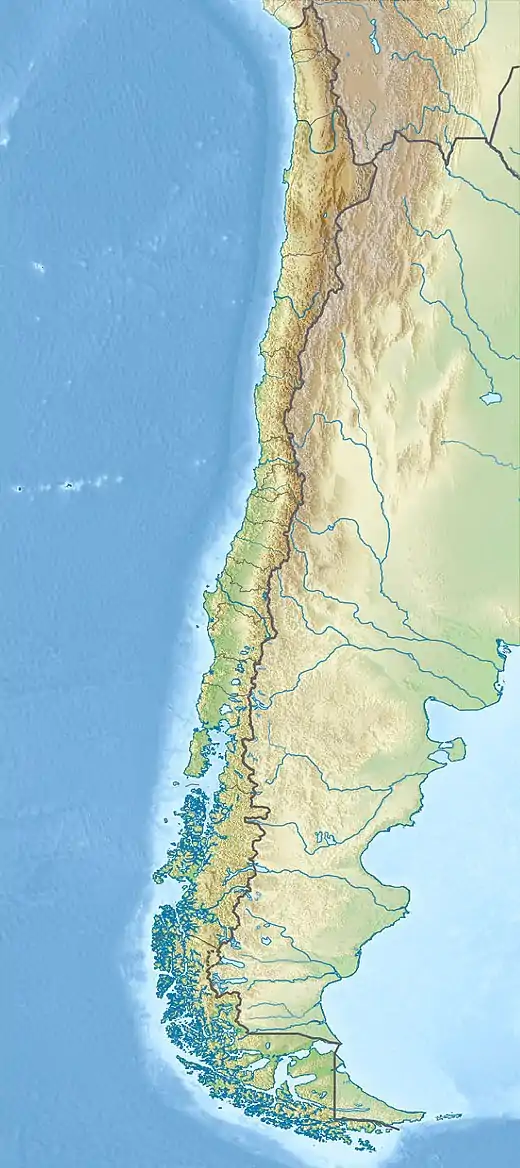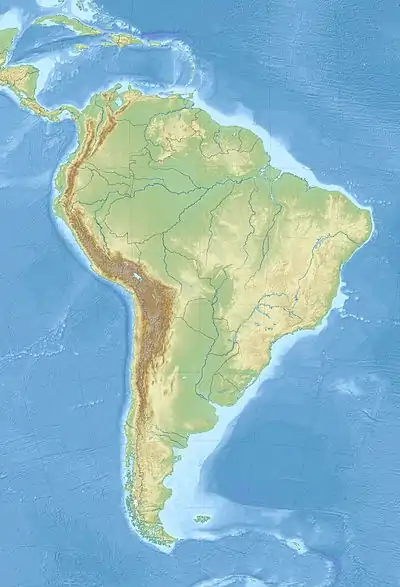| Abanico Formation | |
|---|---|
| Stratigraphic range: Eocene–Miocene (typically Tinguirirican) | |
| Type | Geological formation |
| Underlies | Farellones Formation |
| Overlies | Colimapu Formation |
| Thickness | ca. 3,000 m (9,800 ft) |
| Lithology | |
| Primary | Volcaniclastic sediments comprising basalts, andesites & minor dacites |
| Other | Zeolite |
| Location | |
| Coordinates | 35°00′S 70°24′W / 35.0°S 70.4°W |
| Approximate paleocoordinates | 36°54′S 62°36′W / 36.9°S 62.6°W |
| Region | O'Higgins, Santiago Metropolitan & Valparaíso Regions (Chile) Mendoza Province (Argentina) |
| Country | Chile, Argentina |
| Extent | Abanico Basin |
| Type section | |
| Named for | Cerro El Abanico |
 Abanico Formation (Chile) | |
Abanico Formation (Spanish: Formación Abanico) is a 3 kilometres (9,800 ft) thick sedimentary formation exposed in the Andes of Central Chile.[1] The formation has been deposited in a timespan from the Eocene to the Miocene. Abanico Formation's contact with the overlying Miocene Farellones Formation has been the subject of differing interpretations since the 1960s.[2] A small part of the formation crops out in the Mendoza Province of western Argentina.[3]
Description
The sediments accumulated in the Abanico Extensional Basin within a context of the Andean orogeny. The basin had a north-south elongated shape that spanned the latitudes of 29–38° S. Tectonic inversion from 21 to 16 million years ago made the basin collapse and the sediments to be incorporated to the Andean ranges.[4] The northern part of the basin inverted before the southern part.[2] Parts of the formation are known to have experienced Prehnite-pumpellyite facies metamorphism.[1]
Paleontological significance
The Tinguiririca fauna is known from the fossils found in the Abanico Formation near the Tinguiririca River. The rich faunal assemblage of the paleontological site, located in the La Gloria Member and dated at 33 to 31 Ma, gave name to the Tinguirirican South American land mammal age (SALMA), together with the Friasian named after the Río Frías Formation of the Aysén Region, the only ages defined in Chile.[5]
Fossil content
The following fossils have been recovered from the formation:
| SALMA | Group | Fossils | Notes |
|---|---|---|---|
| Colhuehuapian | Mammals | Chilecebus carrascoensis, Notoungulata indet., Rodentia indet. | |
| Tinguirirican | Andemys frassinettii, A. termasi, Archaeotypotherium pattersoni, A. tinguiriricaense, Barrancatatus tinguiririquensis, Bryanpattersonia sulcidens, Chilestylops davidsoni, Rosendo pascuali, Johnbell hatcheri, Klohnia charrieri, Kramadolops abanicoi, K. mckennai, Pseudhyrax eutrachytheroides, P. strangulatus, Pseudoglyptodon chilensis, Santiagorothia chiliensis, Trigonolophodon cf. elegans, Rhyphodon sp., Astrapotheria indet., ?Borhyaenidae indet., Indaleciidae indet., Notohippidae indet., Tardigrada indet. | ||
| Mustersan | Ignigena minisculus, aff. Ernestokokenia sp., Borhyaenidae indet., Oldfieldthomasiidae indet. | ||
| Casamayoran | Antepithecus brachystephanus | ||
References
- 1 2 Muñoz et al., 2010
- 1 2 Godoy, 2012
- ↑ Muñoz et al., 2006
- ↑ Charrier et al., 2006, pp.93-94
- 1 2 Tinguiririca Locality Sets 1 & 2 at Fossilworks.org
- ↑ Río Las Lenas at Fossilworks.org
- ↑ Cachapoal at Fossilworks.org
- ↑ Tapado at Fossilworks.org
- ↑ Azufre at Fossilworks.org
Bibliography
- Bertrand, Ornella C.; John J. Flynn; Darin A. Croft, and André R. Wyss. 2012. Two new taxa (Caviomorpha, Rodentia) from the early Oligocene Tinguiririca fauna (Chile). American Museum Novitates 3750. 1–36. Accessed 2019-02-15.
- Bradham, Jennifer; John J. Flynn; Darin A. Croft, and Andre R. Wyss. 2015. New notoungulates (Notostylopidae and basal toxodontians) from the early Oligocene Tinguiririca fauna of the Andean Main Range, central Chile. American Museum Novitates 3841. 1–24. Accessed 2019-02-13.
- Charrier, Reynaldo; Luisa Pinto, and María Pía Rodríguez. 2006. 3. Tectonostratigraphic evolution of the Andean Orogen in Chile in Geology of Chile, ed. by Teresa Moreno, and Wes Gibbons, 1–326. Geological Society of London. Accessed 2018-09-08.
- Croft, Darin A.; John J. Flynn, and André R. Wyss. 2008. The Tinguiririca fauna of Chile and the early stages of "modernization" of South American mammal faunas. Arquivos do Museu Nacional, Rio de Janeiro 66. 191–211. Accessed 2019-02-12.
- Engelman, Russell K.; John J. Flynn; Philip Gans; André R. Wyss, and Darin A. Croft. 2018. Chlorocyon phantasma, a late Eocene borhyaenoid (Mammalia, Metatheria, Sparassodonta) from the Los Helados locality, Andean Main Range, central Chile. American Museum Novitates 3918. 1–22. Accessed 2019-02-11.
- Godoy, Estanislao. 2012. Sobre el variable marco geotectónico de las formarciones Abanico y Farellones y sus equivalentes al ser de los 35°LS. Revista de la Asociación Geológica Argentina 69. 570–577. Accessed 2018-09-08.
- Muñoz, Marcia; Luis Aguirre; Marío Vergara; Alain Demant; Francisco Fuentes, and Andrés Fock. 2010. Prehnite-pumpellyite facies metamorphism in the Cenozoic Abanico Formation, Andes of central Chile (33º50'S): chemical and scale controls on mineral assemblages, reaction progress and the equilibrium state. Andean Geology 37. 54–77. Accessed 2018-09-08.
- Muñoz, Marcia; Francisco Fuentes; Mario Vergara; Luis Aguirre; Jan Olov Nyström; Gilbert Féraud, and Alain Demant. 2006. Abanico East Formation: petrology and geochemistry of volcanic rocks behind the Cenozoic arc front in the Andean Cordillera, central Chile (33°50'S). Revista Geológica de Chile 33. 109–140. Accessed 2018-09-08.
Further reading
- Charrier, R., Bustamante, M., Comte, D., Elgueta, S., Flynn, J.J., Iturra, N., Muñoz, N., Pardo, M., Thiele, R. y Wyss, A.R. 2005. The Abanico Extensional Basin: regional extension, chronology of tectonic inversion, and relation to shallow seismic activity and Andean uplift. Neues Jahrbuch für Geologie und Paläontologie Abh. 236: 43-77
- J. J. Flynn and A. R. Wyss. 2004. A polydolopine marsupial skull from the Cachapoal Valley, Andean Main Range, Chile. Bulletin of the American Museum of Natural History 285:80-92
- J. J. Flynn, A. R. Wyss, R. Charrier and C. C. Swisher. 1995. An Early Miocene anthropoid skull from the Chilean Andes. Nature 373(6515):603-607
- Fock, A., Charrier, R., Farias, M. y Muñoz, M. 2006. Fallas de vergencia oeste en la Cordillera principal de Chile: inversión de la cuenca Abanico (33°-34°S). Asociación Geológica Argentina, Serie Publicación Especial 6: 48-55
- Godoy, E., Navarro, M. y Rivera, O. 1996. Zonas triangulares en el borde occidental de la Cordillera Principal (32°30'- 34°30' l.s.), Chile: Una solución a la paradoja Abanico - Farellones 13° Congreso Geológico Argentino y 3° Congreso de Exploración de Hidrocarburos, Actas 2: 373-381, Buenos Aires
- R. B. Hitz, J. J. Flynn, and A. R. Wyss. 2006. New Basal Interatheriidae (Typotheria, Notoungulata, Mammalia) from the Paleogene of Central Chile. American Museum Novitates 3520:1-32
- M. J. Novacek, A. R. Wyss, D. Frassinetti and P. Salinas. 1989. A new ?Eocene mammal fauna from the Andean Main Range. Journal of Vertebrate Paleontology 9(3 Supp.):34A
- Vergara, M.; Morata, D.; Villarroel, R.; Nyström, J.O.; Aguirre, L. 1999. 40Ar/39Ar ages, very low grade metamorphism and geochemistry of the volcanic rocks from “Cerro El Abanico”, Santiago Andean Cordillera (33º30’S-70º25’W). In International Symposium on Andean Geodynamics, No. 4, Extended Abstracts: 785-788. Göttingen
- A. R. Wyss, J. J. Flynn, C. C. Swisher, III, R. Charrier, and M. A. Norell. 1992. Fossil mammals from the central Chilean Andes: a new interval in the South American land mammal succession, and implications for Eocene-Oligocene events and Andean tectonics. Abstracts and Program, Fifth North American Paleontological Convention 318
